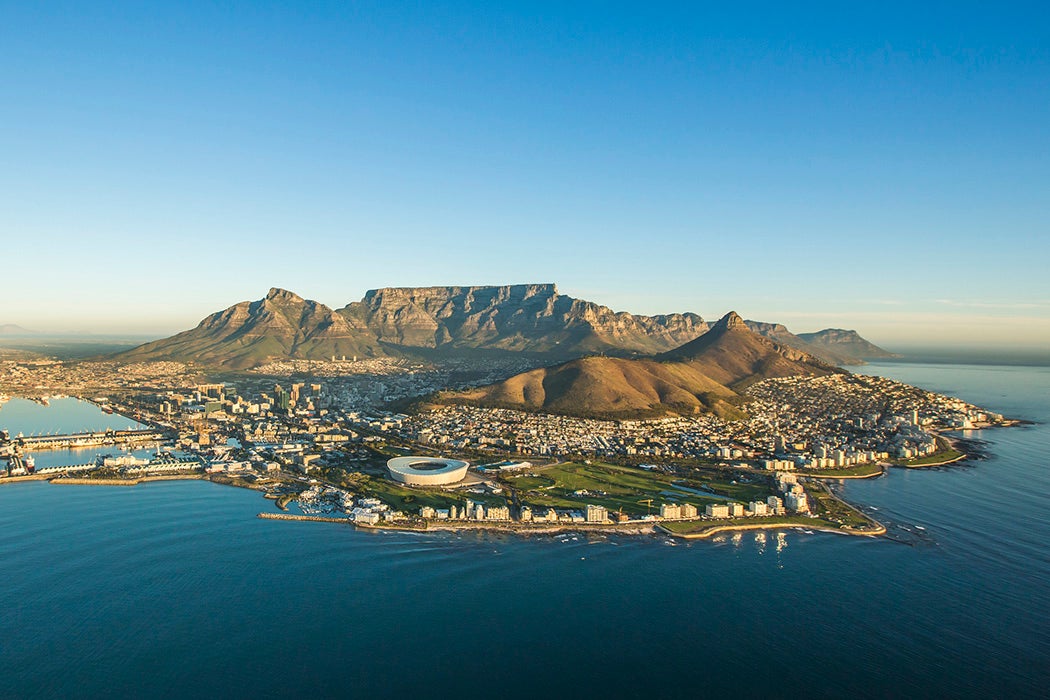It’s not quite the most southerly point in Africa (you have to travel another 200 kilometers farther south to Cape Agulhas to reach the true foot of the continent), but Cape Town has long had a global reach and influence that belies its geographical extremity.
Most histories of the city begin with the tussle between the Dutch and the British for colonial control after Jan van Riebeeck, who was sent by the Dutch East India Company to set up a supply station for ships making the passage from Europe to India, “discovered” the region in 1652.
Of course, a long-established Indigenous population already lived there. Collectively called the Khoesān, a portmanteau of the Europeanized names of the Khoekhoen and Sān peoples, the original inhabitants referred to the area as //Hui !Gaeb (“Where the clouds gather”), and gave kilometer-high Table Mountain its first name, Hoerikwaggo, meaning “mountain in the sea.” By the mid-eighteenth century, Table Mountain was a colonized space, functioning as a commons worked by Cape Town slaves.
Historian Andrew Bank explores the limits placed on the history of Khoekhoen by racially structured historiography. He points to the 1820s and 1830s, when early (white) Cape liberals tied the plight of Cape slaves and Khoekhoen to the abolitionist movement. Neither Dutch farmers, “whose ideas were moulded by almost two centuries of forced labour,” nor “land-hungry” British settlers had sympathy for the abolitionist position. These competing ideologies, which shaped future written histories, often relegated Indigenous people to pejorative footnotes or positioned them as innocent primitives; Khoekhoen were at the center of competing settler ideologies, but only as voiceless subjects.
Cape Town’s Muslim population has been there for as long as the city has existed, originally brought to South Africa as enslaved laborers. The abolition of slavery in 1834 led to the expansion of a distinctive area called Bo-Kaap at the foot of Signal Hill, next to Table Mountain. Today a rapidly gentrifying cluster of pastel-colored cottages, mosques, and restaurants, the neighborhood’s roots go back to a time when it was place of relative freedom for those who the trade winds and the shackles of slavery brought in from Malaysia, Indonesia, India, and China.
The story of Cape Town in the twentieth century is stained by apartheid, a system that brought widespread changes to every facet of the city, including the demolition of an entire neighborhood, District Six. Duane Jethro argues that District Six, once home to a racially mixed community but now a vacant, weed-strewn area, functions as “a utopian space of Fairyland, a degenerating space of Wasteland, and a lost space of Exile” for its former residents. Still considered a highly sensitive topic for Capetonians, the history of District Six reveals how a community
was stripped of their humanity through forced removal, demolition and banishment to a dehumanizing world, and then recover[ed] a sense of dignity and humanity from within this experience of humiliation and dispossession by invoking the spirit of their former home.
In the aftermath of apartheid, the area became a focal point for the dispossessed, a “symbolic space” of both marginalization and liberation.
Fourteen kilometers off the coastline lies the forlorn remnants of the Robben Island prison. Today, former inmates lead tours around the grim facility that housed Nelson Mandela for the majority of his twenty-seven-year sentence. Richard Marbeck discusses the idea of Robben Island as a “rhetorical space” that illustrates the dysfunctional violence and repression of the apartheid regime.
Weekly Newsletter
Today, the view from the summit of Table Mountain takes in one of the most diverse cities in the Southern Hemisphere. Up on the “table top,” as locals call it, you’ll have some unusual company in the form of the rock hyrax, small mammals more commonly known as “dassies.” Incredibly, as an 1880 Scientific American article proposes, far from being a member of the rodent family, as was long assumed to be the case, the dassie is more closely related to both the hippo and the rhinoceros.
Although the apartheid era continues to cast a shadow over the city, many Cape Town neighborhoods have been enjoying a renaissance as tourist destinations. Perhaps the greatest example of how far the city has come since the 1970s and 1980s is the emergence of Greenpoint as a hub for gay nightlife. A 2006 interview with art curator and academic Utando Baduza offers a fascinating look into the lived experiences of Black and gay men in this challenging—yet fascinating and staggeringly beautiful—city.







